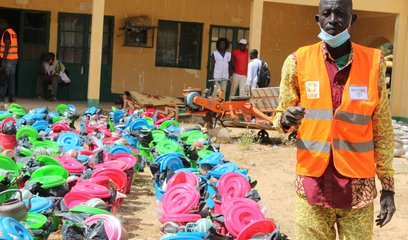-
3.4 million
3.4 million people require humanitarian aid
-
60 %
60% of the population do not have access to clean water
The central African country of Cameroon, situated between the Atlantic and Lake Chad, was long considered relatively stable. However, tensions have increased in recent years. The conflict, in the north and south-west between separatist groups of the Anglophone minority and the government in the majority French-speaking Cameroon, has claimed thousands of lives since it began in 2017.
In the Lake Chad region in the north of the country, there are repeated attacks that spread terror, killing people and forcing the population to flee. The situation is also tense on the country's border in the east, where hundreds of thousands of people from the Central African Republic are fleeing to Cameroon.
Precarious humanitarian situation
Due to the ongoing violence, the need for humanitarian aid remains high: 3.4 million people required humanitarian aid in 2024. One million people are displaced within the country. 55 percent of them are children. They mainly come from the crisis-hit regions in the far north, north-west and south-west. There are also 489,000 refugees and asylum seekers in the country, mainly from the Central African Republic and Nigeria.
At least 2.5 million people do not have enough to eat. Only 40 percent of the population have access to clean drinking water; more than 600,000 people lack shelter.
Medical care is also inadequate: some health facilities have already had to close due to repeated attacks. For women and girls, there is increased risk of unwanted pregnancies and gender-based violence. Safer access to medical care, water, hygiene and sanitary facilities is essential in order to reduce the spread of diseases such as cholera and the dangers for women and girls.
In the north and south-west, educational institutions are repeatedly the target of armed attacks. 36 percent of schools are non-functional. Countless children are therefore denied access to education.
Extreme weather
Cameroon is also suffering greatly from the consequences of climate change. Heavy rainfall in central and west Africa was followed by severe flooding in September 2024, with more than 350,000 people affected in Cameroon alone.
From January to April 2024, there were several fires in settlements for internally displaced people in the north and many shelters were destroyed. Most of the fires are due to accidents, but the spread of the flames is often driven by heat and strong winds in the region. The consequences of climate change, such as floods, droughts and heat, are jeopardising the livelihoods of farmers, herders and fishermen in the country.
CARE in Cameroon
CARE has been active in Cameroon since 1978 and works primarily in the areas of water supply, environmental protection, food security and HIV prevention. In the northern regions, CARE is providing support in the form of cash, hygiene and health packages, food and the construction of shelters. CARE also provides humanitarian and psychosocial aid for refugees from the Central African Republic and supports the local communities around the refugee camps.
Ten forgotten crises
The CARE Crisis Report is published annually and highlights the ten crises that receive the least media attention. In 2024 Cameroon ranked as the seventh least reported crisis in the world.
